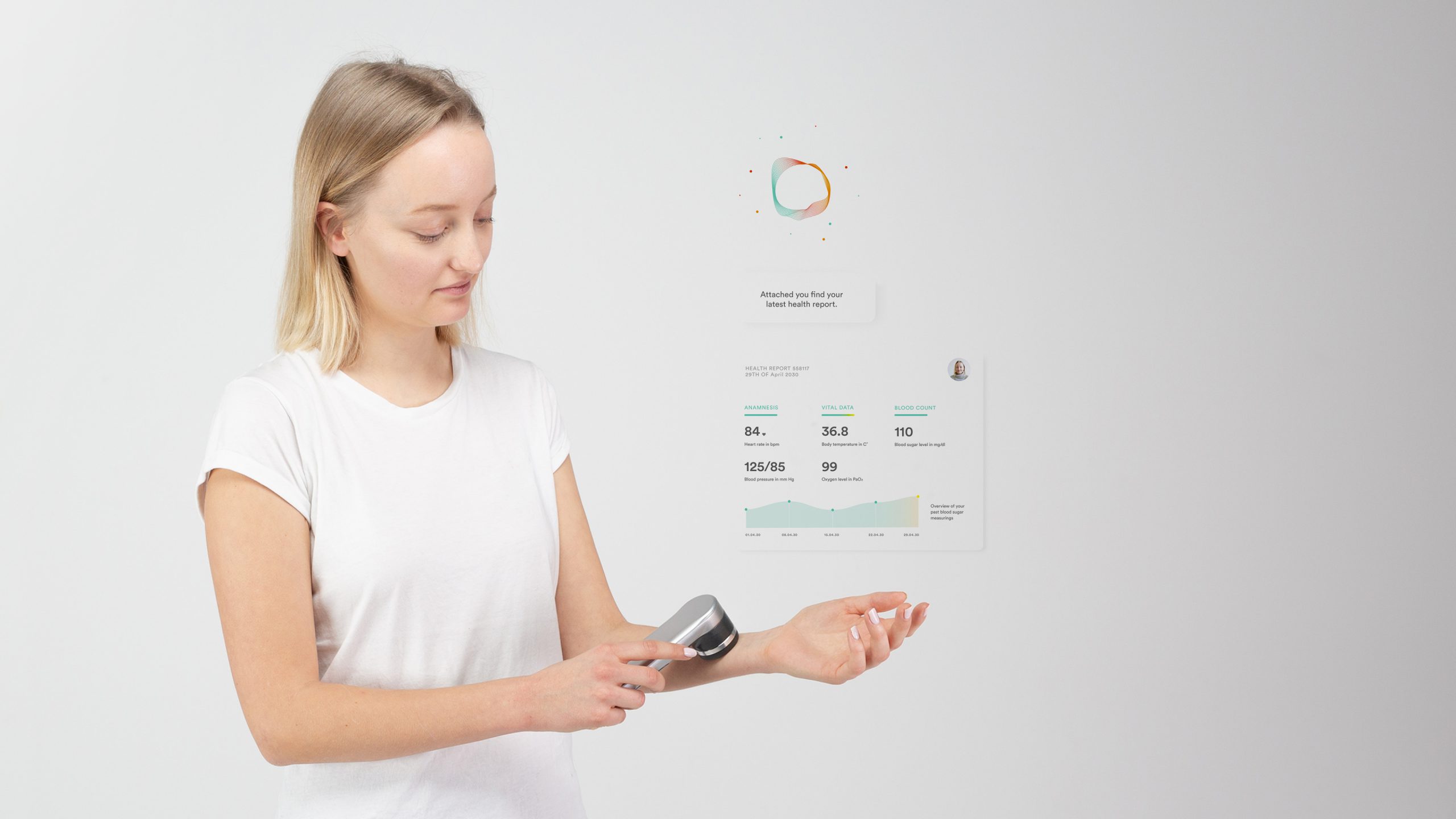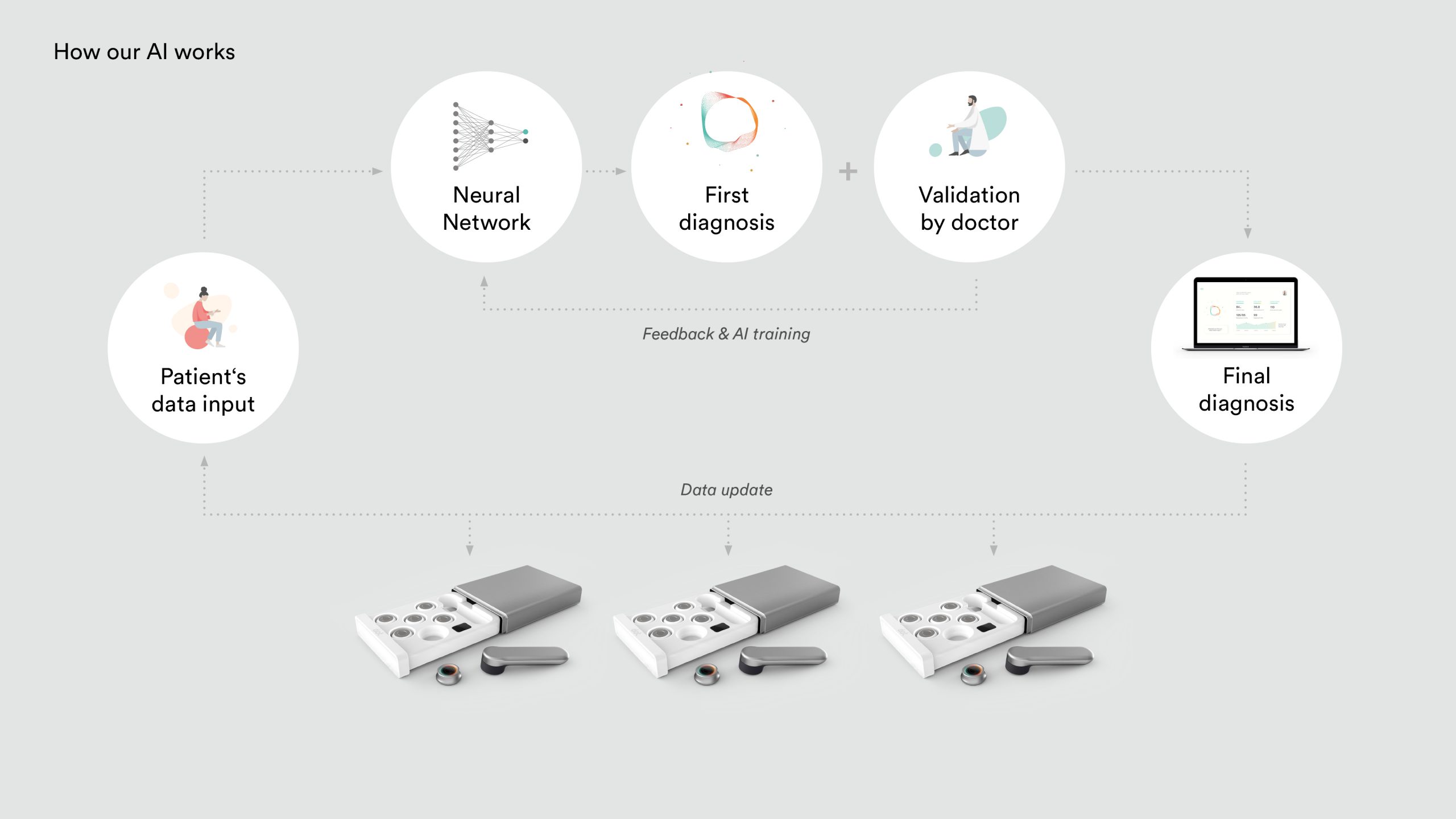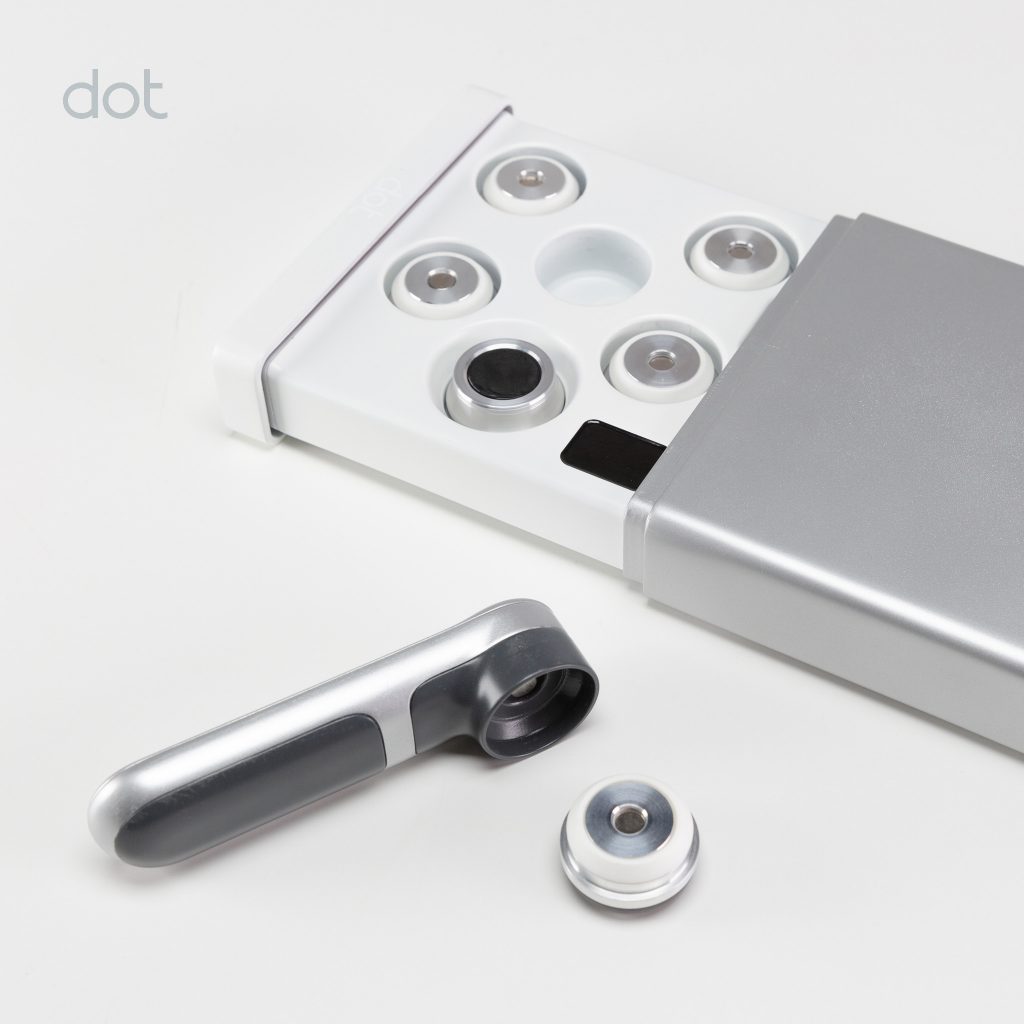dot – keep your health in your hand
With dot doctor’s practices and emergency rooms are relieved. Through the interaction of human experience, artificial intelligence and mobile a technology, dot enables the patient to get a precise diagnosis with personal medical care. Anytime and anywhere.





"dot is a holistic concept that clearly offers a novel approach to receive a preliminary medical diagnosis with very little effort. Based on data generated by the user, the time available to a doctor could be balanced out and reorganized in a new, more beneficial and effective way. Yet dot looks beyond efficient treatment and automated documentation only. In a comprehensive way, this concept could create more space for patient empathy and lead to a human-oriented health system."
Johannes Geyer (UXDA Jury Member and Head of Design Laundry Care, Global Brand Siemens, B/S/H)
Healthcare 2030
A human-centered
approach to
future healthcare
The Result
The aim was to create a service which optimizes anamnesis processes and relieves the burden on doctors and emergency rooms by means of a preliminary diagnosis. In this way, medical capacities and resources can be distributed efficiently. Moreover a digital and uniform recording of patient data should simplify the communication between doctors and patients.
This is made possible through our platform-based dot-service and our dot-case. Guided by the Artificial Intelligence Liv, the patient can describe her symptoms and identify the necessary measured values by using a handheld device. The interpretation of the sensible data is done by Liv, whereby the final diagnosis must always be approved by a doctor.
Challenge
People are living longer than ever before. Despite this, the WHO states that 60% of all deaths are due to chronic illnesses, such as heart diseases, chronic respiratory diseases, strokes, cancer and diabetes. Further, there is an increasing shortage of doctors and long waiting times for appointments, especially in remote areas. In particular for elderly people going to the doctor can become seriously challenging.
In addition, four out of ten cases in emergency rooms turn out not to be acute (cf. Techniker Krankenkasse 2019). Capacities needed for urgent cases are blocked by people who misjudge their symptoms and go there without consulting a doctor beforehand. This causes unnecessary stress to medical staff and doctors.
Define
How might we provide a fast and precise medical diagnosis for patients in their own homes?
In the course of our research we spoke with several potential users as well as medical experts. Among them were a care service manager and a chief doctor of a hospital. In order to structure the complex contents of our research we identified several key findings for patients and doctors. For example a lack of insights into the health reports of each patient, long waiting times for medical appointments or a more difficult access to health care in rural areas and for elderly people.
Synthesis
A variety of methods from the field of Service and Business Design was applied. In this way, the wicked problems were clustered to identify the interconnectedness of things and gradually gain clarity about the actual problems. After extensive research and interviews with experts and patients, we identified our key insights in order to structure the complex contents of our research. These are usually key factors of an overall problem.
Prototype
During the ideation phase, a very divergent approach was taken in order to generate as many ideas as possible. With the help of user testings, the best design was determined and prototyped. Next to examining the feasibility and product design, we focused on the development of a user-centered service and a viable business model.
After developing the first foam prototypes we validated our steps continuously with doctors and patients to create a product and service which takes both parties into account. The foam mockups were iteratively tested to ensure comfortable and easy handling. Same was done with the case. Since we structured our project into phases our first partner would be the doctor who is partly responsible to train our algorithm by using single dots to examine the patients.
Test
It was possible for us to conduct a user testing in the UX laboratory of Fraunhofer IAO in Stuttgart. Here we tested our final prototypes and our service for its user experience and general usability with different test persons. Altogether we conducted over 15 user interviews at an early stage to find out the needs and desires for an AI home diagnosis system. This allowed us to verify our assumptions and further improve our product. The next step would be to make a few adjustments on the communication between our diagnosis system and the user.
Implement
The final version consists of our dot-case, an interface for communication and our artificial intelligence Liv. The dot-case contains five examination dots, a communication dot for user-AI interaction and a handheld to conduct the examination. Guided by Liv, the patient can describe his symptoms and identify the necessary measured values by using the handheld device.
The interpretation of the data is done by Liv, whereby the final diagnosis must always be approved by a doctor. Moreover we developed a valid service model as well as a financial model to proof the viability and feasibility of our project. (To see dot in action, please view the video below)
Meta Level
In his new role the doctor is relieved. We expand the circles of trust and the radius of action of both sides through simple anamnesis, precise diagnoses and transparent patient management. We form the new intersection between doctor and patient. Doctors can thus focus on the relevant patient care. On the patient side, access to medical care is made easier and seamlessly adapted to their everyday life.
The dot ecosystem
What makes dot an innovative concept is the holistic approach, combining human experience, state-of-the-art sensor technology and advanced AI. dot not only offers a fast preliminary diagnosis, but a whole ecosystem to connect with medical specialists quickly and to have sensible health data of patients stored securely.
The dot case
The dot cases are being used collaboratively as a Product-as-a-Service-System and are not available for commercial sale. A modular design enables fast repairability of the individual units – based on Circular Economy principles. A subsidy from health insurance companies makes dot available and affordable for anyone who needs medical care.
They contain five examination dots to measure different health values. For example an infrared sensor for blood oxygen or a high resolution camera to identify skin alterations. Lastly, the communication dot which connects the patient with our AI Liv.
The dot platform
Through the dot platform the patient can monitor his/her health data in one central place. So it is also possible to detect diseases at an early stage. Furthermore the patient has full control over his data and is able to share the information with GPs and doctors.
Data security has a very high priority for our company. We ensure it by offering an independent service which does not allow access to the patients’ sensible health data for Google, Apple, Huawei and Co.
Our AI Liv
Liv works with advanced NLP (Natural Language Processing). Because of this, the conversation is more natural and Liv makes the patient feel less alone or isolated during his/her course of disease.
(Explanation for infographic at bottom) Firstly, the patient executes a self examination with the dot sensors and the neural network processes the data. The diagnosis is then being sent to the patient who can get an online appointment with a doctor afterwards. The diagnosed data is validated by the expert and thus helps to train the neural network.
Through the collaboration of AI and human experience the final diagnosis is prepared. The system is then being updated with the newly input data and made available to all cases worldwide. Since the system is globally connected, dot learns fast and develops into a comprehensive health knowledge database. When reaching a high confidence level in diagnosing our system can work independently without the expert validation.
Service & Viability
Our service and viability model enables a holistic communication between all stakeholders. The patient is linked to his GP, who can view the patient’s data upon his/her permission. After ordering the case online or via call, s/he can obtain the case via home delivery or pick it up at a local pharmacy. After usage the case is being sent back and our company takes care of hygienic cleaning and storing.
In Germany health insurance companies receive a regular contribution by their members. We collaborate with them to ensure viability and to expand their service offer.
Delivery
We focus on collaborative use. The dot case will be delivered to the patients home within half an hour and returned after use. Thus, resources are used more effectively.
Pharmacies
In addition to a delivery, the cases can also be picked up at cooperating pharmacies. Since many older people prefer this option. The staff is on site as a contact person if help is needed.
Doctors
We work together with general practitioners and specialists from all medical fields. They use our system to monitor the process of therapy and chronic diseases.
Cleaning
After successful use the case will be returned. We take responsibility for the maintenance, storage and sterile cleaning of the case with the highest standards of hygiene.
Funding
We cooperate with health insurance companies in order to obtain a sustainable business model. They benefit from our service and subsidize a part of the costs for the customer.
Project Photos
& Videos
General Info
Supervisors:
Prof. Dr. Susanne Schade
Prof. Gabriele N. Reichert
Thomas Schönweitz
Strategic Management
Strategic Design
Winter’s semester
2018 – 2019
Publications
Souverän in die digitale Zukunft – 05/ 2019 Bundesministerium für Bildung und Forschung
Masterstudenten gewinnen bei Ideenwettbewerb
Hochschule für Gestaltung Schwäbisch Gmünd
My role
Product Concept
Strategy
Service & UI Design
Photography & Videography
User Research
Team
Miriam Brüne
Andreas Kissling
Thomas Memel
Andreas Hutter
Nagihan Avcu
Awards & Nominations
iF Design Talent Award Winner 2020
by the iF Design Foundation
Awarded in New Talent Category 2020
Innovation Award Ostwürttemberg by WIRO &
Kreissparkasse Ostalb in Aalen
Winner in the New Talent Award 2020
The UX Design Awards by IDC in Berlin
Shortlisted – AI 100 Design Competition 2020
The RSA in London
National Winner –Digital Future Competition 2019
German Federal Ministry of Education & Research
National Finalist – Future Convention 2019
Future Award 2019 | DVPT e.V.
ceero.
Business Model Innovation
for a Circular Economy
ARCOS
Adaptive Intelligence for
your car
VERT
Brand Strategy for a green
Start Up



























